Eva Respini stepped down from being chief curator at Boston’s Institute of Contemporary Art last month. She hasn’t announced her plans, but on the heels of curating the U.S. pavilion at the Venice Biennale it’s likely she will continue to play an important role in the contemporary art world.
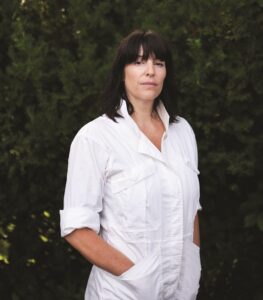
In the meantime, she has sold her house in Cambridge and is spending more time in the Wellfleet house she shares with her husband, Jacob Dyrenforth, their 12-year-old daughter, and two cats. “I’m just trying to enjoy not having a job for the first time in my adult life and really take a break,” says Respini during an interview at Flying Fish Cafe. “The last couple of years were pretty intense.”
The ICA is currently showing the work of Simone Leigh in the sculptor’s first survey exhibition. This show, along with Leigh’s 2022 exhibition in Venice, has occupied Respini for the last few years. “I invited her to do a show and a monograph publication,” says Respini, but “I felt that her work needed to be seen on an even bigger stage.”
Respini submitted Leigh’s work for the U.S. pavilion at the Biennale, one of contemporary art’s most prestigious events. It’s very competitive, so Respini was thrilled when her proposal was selected.
“I was on my deck in Wellfleet when I got the phone call that the State Dept. had approved our application,” says Respini.
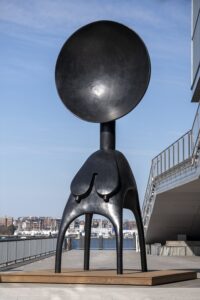
That put plans for the ICA exhibit on hold. “As curator, my role was to make the idea happen,” says Respini. This involved working closely with Leigh on fundraising and surmounting logistical challenges, such as persuading the Landmarks Commission in Venice to allow the U.S. pavilion, a historical building, to be covered with a thatched roof. The pandemic made things uniquely challenging: most studio visits were over Zoom, shipping was stalled, and Leigh had to figure out how to create a site-specific installation without visiting the site. Nonetheless, the exhibition opened in April 2022 to enthusiastic reviews, with over 650,000 people visiting the show.
The current ICA show builds on Leigh’s success in Venice. Leigh works primarily in a figurative mode, sculpting singular images of Black women, their bodies often merged with domestic objects like urns. She is a sculptor’s sculptor, attentive to the formal concerns of volume, scale, and surface, but her work also reverberates with a range of emotions from mournful to celebratory, and she takes on weighty conceptual issues, like Black feminism and colonization. In my conversation with Respini, we talked about Leigh’s work, Respini’s role as a curator, and her observations of the Cape.
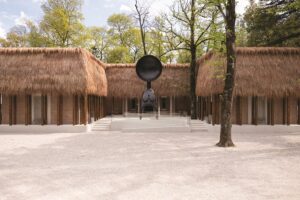
A.S.: How did you become interested in Simone Leigh’s work? What did you see that made you feel it should be celebrated?
Eva Respini: In 2018 and 2019, she had a series of very visible moments in New York. People talked about her as if she were an emerging artist, but she had been working for a really long time, primarily in ceramics, and putting forward Black women as her topic. While these ideas are perhaps more popular now, for a long time they weren’t. She’s very sure of her visual language. She knows exactly what she’s making and who she’s making it for.
What are some similarities and differences between Simone Leigh’s exhibition at the Biennale and the one at the ICA?
They are interrelated, but they’re two different things. Many aspects of the Venice exhibition are extremely site specific, like the façade piece, which reflected colonial histories with its thatched roofing that transformed this Monticello-like building into an African palace. At the ICA, people can see the Venice works as part of the larger conversation and how her career unfolded.
What do you enjoy most about being curator?
I enjoy making arguments in space. It’s like dramaturgy. Everything about the setting creates a narrative about the artwork.
I believe in the power of art in person. If the pandemic confirmed anything to me, it’s that looking at images on Instagram or online will never hold a candle to what happens when you’re in front of an artwork.
What’s your background? How does it inform your work as a curator?
I had a peripatetic upbringing. I have three citizenships: Italian, Norwegian, and just this month I became a naturalized U.S. citizen. By the time I was 18 I had lived in five different countries. I sometimes reflect that maybe it’s why I ended up in the curatorial field. When you live in many places as an outsider, you become an observer of cultural codes and body language. This made me a sharp observer. Also, a lot of the artists I’m thinking about are beyond the scope of traditional North American, Western European art history. My experience of moving around a lot informed that.
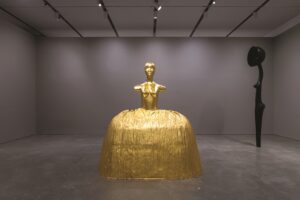
What was meaningful about your experience at the ICA?
Prior to the ICA I was at MoMA, which is an amazing institution, but I was one of 46 curators. At the ICA, I came to be chief curator and, with the team, I could mold and direct the program.
The last eight years at the ICA has been about expanding our notions of what art can be and thinking about the stories that are not often told, like those of women or artists of color, or showing mediums or art forms that are not typically part of the canon.
Identity has become so central to the way art is presented. Why is that?
Work that deals with identity has been at the forefront of a lot of contemporary art discourse, including the work that I’ve done. At certain moments in history, it’s very important. In the case of Simone Leigh, it is important that she’s the first Black woman to represent the United States in this huge platform.
Now, should that headline preface every conversation about her work? No. Because the work is about so much more than that. Her identity can’t be the only way that the artwork is discussed because then it’s tokenism.
Successful artwork has to live beyond the moment and have resonance in other time periods. Right now, questions are being raised around who has a seat at the table, whose voice is prominent, who is remembered. These are the key questions of our moment. That’s why I think we see a lot of work that is coming from a specific point of view, whether it’s an indigenous artist or femme-presenting artist or an artist from a certain part of the world that says my experience is important to the understanding of this work of art. But there are many artists who would not see it that way, and their feathers would be ruffled to be put in some category, as if their art can only be read through that lens.
What’s your connection to Wellfleet? What do you enjoy about this place?
We’ve had a home here for five years. Since I grew up in many different places, home is where I choose. I’ve thought about this a lot in Wellfleet, because this is a place where many generations come. I’ve never had that, but I feel deeply connected to this place. I definitely expect to spend more time here. Just crossing the Sagamore Bridge, I feel lighter.
We love the landscape and its history as a place where independent spirits have been supported and forged. Hopefully, that’s a legacy that continues and remains, although I do worry. It’s hard to live here as an artist.
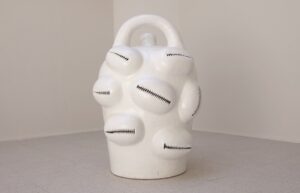
What is the value and viability of regional art communities, like the Outer Cape, that exist as alternatives to the major urban art centers?
I started thinking a lot about the local during the pandemic, when the only place we could go to as curators was our own back yard. There was a lot more awareness of how rich the local can be and its idiosyncratic nature and how it deserves support. At the ICA, for example, we focused all our acquisition funds on buying artwork by Boston-based artists during the year of the pandemic.
On the Cape, I think a lot about the periphery, being out in the middle of the North Atlantic on this little bitty piece of sand. The periphery can be productive because there’s less pressure, there’s a sense that you can innovate, you can experiment, you can take risks. When that periphery becomes part of mainstream thinking or mainstream histories, one realizes the need for those peripheries in order to innovate and bring cultural production to a new place.
I think the cultural history of the Outer Cape, in not just art and architecture but also poetry and theater, is due to that periphery nature. What’s amazing is that it has had an international and global reach. For example, the imprint of what the modernist architects learned and saw and built here is now felt throughout architecture.
However, if local art communities don’t have a strong economic engine, whether it’s a gallery system or foundations or an organization, I worry about those communities and their ability to survive.
Survey Exhibition
The event: Sculpture by Simone Leigh
The time: Through Sept. 4
The place: Institute of Contemporary Art, 25 Harbor Shore Dr., Boston
The cost: General admission: $20
